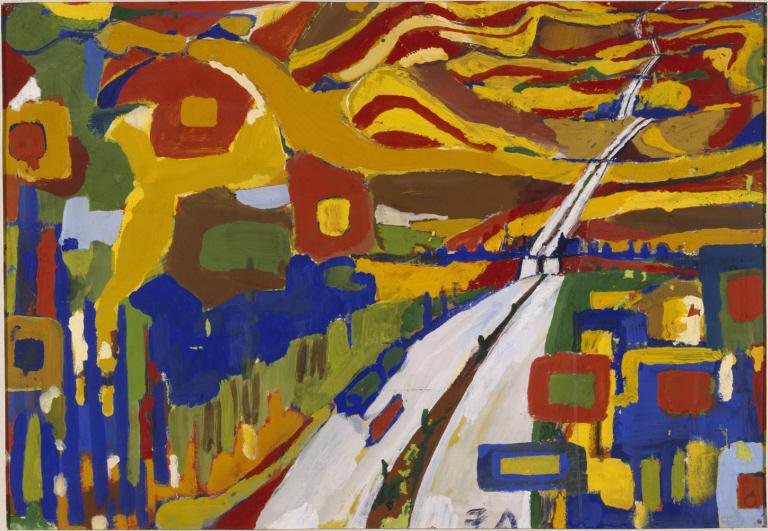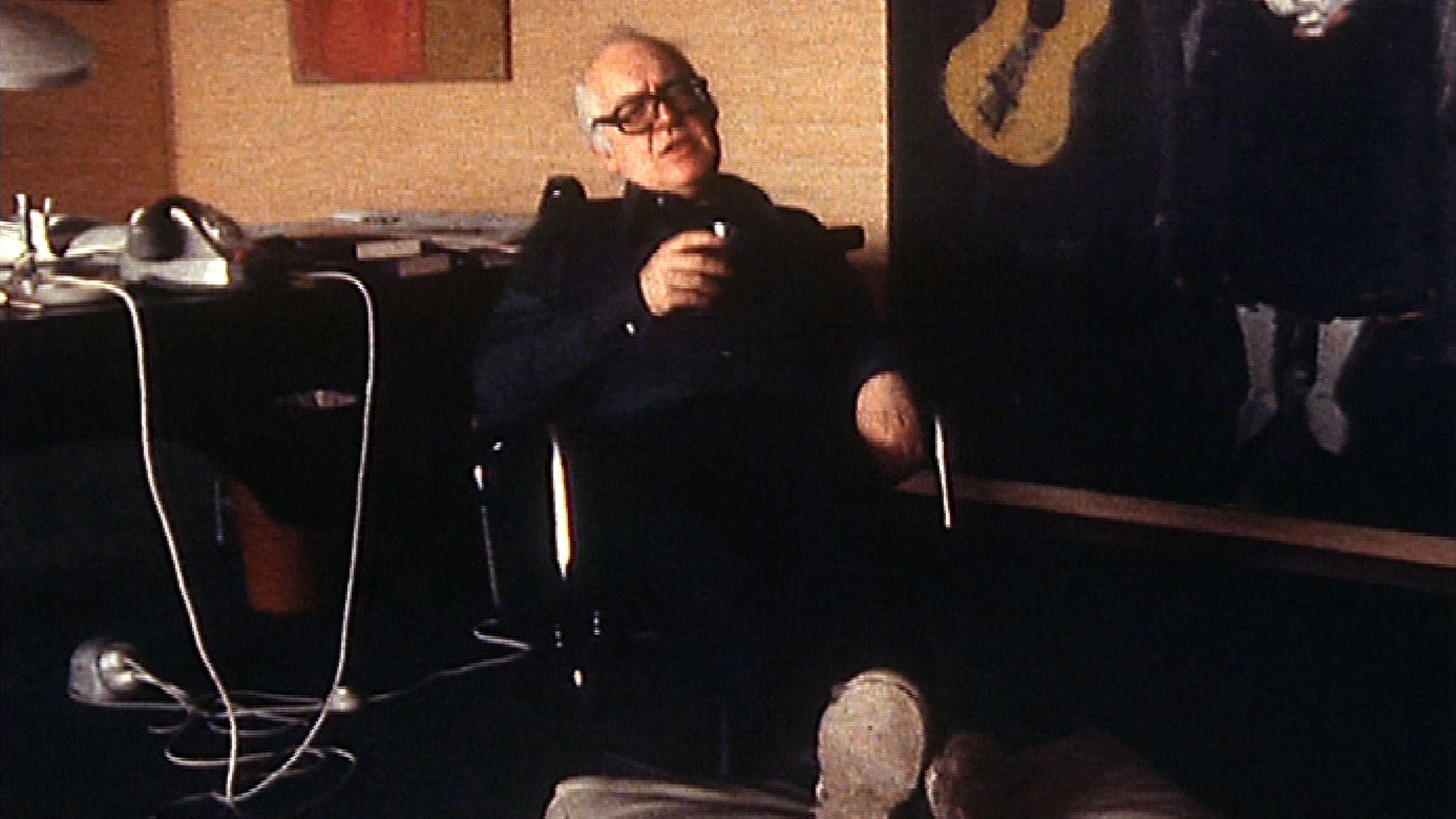
Dürrenmatt: ‘I paint because I think’

This year marks 25 years since the death of Friedrich Dürrenmatt, one of Switzerland’s most renowned writers. But fewer people are aware the writer was also an enthusiastic painter, giving expression to his ideas also through art.
“I paint like a child but I don’t think like a child. I paint for the same reason that I write: because I think,” is how Dürrenmatt defined his passion for creating art.
It was ten years after Dürrenmatt’s death in 1990 that his widow Charlotte Kerr succeeded in gaining recognition of the importance of her husband’s artistic works. The Centre Dürrenmatt Neuchâtel (CDN) was inaugurated in 2000 and today houses a collection of some 1,000 drawings, etchings and paintings.
Located at the top of Neuchâtel at the end of a narrow and winding road, the CDN is a building of black stone streaked with grey – characteristic of Ticinese architect Mario Botta – that encompasses the writer’s former home. From the terrace, one has a view that stretches over the town and its lake as far as the Alps, and it is here that Dürrenmatt lived from 1952 until his death.
Anniversary year
The Centre Dürrenmatt Neuchâtel has launched the Year of Dürrenmatt, with a number of events to commemorate the 25th anniversary of the writer’s death and the 15th anniversary of its establishment with the mission to collect, conserve and publish his pictorial works.
Botta, who was friendly with Dürrenmatt during his lifetime and put together a retrospective of his works at Zurich’s Kuntsmuseum in 1991, designed both the museum and the layout of the exhibition.
Metaphors for thoughts
Located in the basement, the permanent exhibition occupies a large space, lit with subtle light that is traversed by a mezzanine. Used to highlight the key dates of Dürrenmatt’s literary work, the mezzanine works as a kind of bridge to his artistic works.
“All the difficulty – but also the luck – was in installing the paintings of an author who was not a painter,” says Botta. “So we tried to transform them into objects that became metaphors for his thoughts. The paintings do not have frames and, instead of being hung on the wall, they are suspended below so as to be detached.”
But one exception is ‘Final general assembly of the federal bank establishment’, an oil painting which depicts the collective suicide of bankers.
“It’s a small, grotesque, ironic painting which Dürrenmatt gave a gold frame,” explains Botta. “We have underlined this symbolic frame by giving it a monumental aspect, to emphasise the idea of a political or ideological will.”
Director of the CDN, Madeleine Betschart, says Dürrenmatt’s passion for art was a particularly personal one, and notes that he exhibited very little publically during his lifetime.
“Dürrenmatt said that he thought in images, that drawing and painting allowed him to express what he was unable to write,” says Betschart. “One could say that it was a personal passion. However, very little was exhibited publically. He developed his own pictorial language, but of course, had influences. His library, which has remained in place, contains a number of books about art which confirm his culture and curiosity.”
For Ulrich Weber, manager of the Dürrenmatt collection at the Swiss Literary Archives, the artist was a solitary operator.
“First, he was self-taught, and then he stayed figurative, far from contemporary movements and especially the avant-garde. And, in any case, he hated the idea of becoming part of one category or another,” says Weber.
Weber believes that Dürrenmatt’s art is complementary to his writings for biographical reasons. When aged just 25, Dürrenmatt toyed with the idea of becoming an artist before he took up writing.
“Next, as a writer, and especially as a playwright, he was sometimes confronted with violent reactions from the public and critics,” says Weber. “He was more vulnerable than he wanted to reveal. So it was important to hold on to an area where he could express himself with total freedom. Painting was a recreation.”

More
Autodidact maybe, but a talented one
‘Images are the battleground’
The drawings, and especially the often pitiless caricatures, make up a good part of the CDN collection. There are also some oils, several water colours and, in later years, Dürrenmat also made lithographs.
Theologian Pierre Bühler met the artist when he was a professor at the University of Neuchâtel (he currently teaches in Zurich). He has dedicated several studies to Dürrenmatt, including an article on the figure of Don Quixote, ‘Knight of hope and faith in the written and drawn work’ (2011).
“Dürrenmatt always pointed out that he did not have any training as a painter and yet his works were impressive,” says Bühler. “It was not by chance that he worked on the same motifs in writing and drawing because, by his own admission, ‘images are the battleground’ on which he wrestled with his literary themes and, perhaps, with himself. So it’s a parallel work, like an outlet when he was blocked in his work as a writer.”
As for the recurrent themes of the Bible and Greek mythology, “they were always linked to a confrontation between the human being and failure, the fall, solitude, death, the absolute. So the Minotaur in his labyrinth evokes this fundamental position of man. In his biblical themes, the believers do not have a particular statute, they fight and fail like the others,” says Bühler.

More
Friedrich Dürrenmatt’s other creative outlet
“The son of a preacher, Dürrenmatt could say of himself in playing with words: ‘I am protestant and I protest’. He accepted his confrontation with the Christian faith of his parents, but always in the same critical manner. At the end of his life, he called himself an atheist, probably because of the radicalisation of his protestations against the systems, ideology and fanaticism.”
An ambiguous artist
Myriam Minder, a doctoral student at the University of Neuchâtel, is writing her thesis on Dürrenmatt the artist, for the first time giving him a place in the world of art history.
“In relation to the world of artistic creation during his time, Dürrenmatt does not feature at all,” says Minder. “He interprets known subjects, but in a roundabout way: we think we have recognised something and we realise that he has interpreted it. For example, he represents the Wedding at Cana as shameless carousing. He is full of surprises.”
The largest Dürrenmatt exhibition was organised in 1985 at the Museum of Art History in Neuchâtel. By looking through the archives, Minder noted that other institutions wanted to show the exhibition as well, but that Dürrenmatt refused.
“He agreed to exhibit, but then he backed out,” says Minder. “This attitude reveals the same ambiguity as when he says ‘I am not a painter’, although he painted himself dressed as a painter. But after all, what is a painter?”
Friedrich Dürrenmatt
The son of a preacher, Friedrich Dürrenmatt was born May 5, 1921, in Konolfingen (Bern) and died December 14, 1990, in Neuchâtel.
He is the most translated Swiss writer and playwright in the world and made his name with the works ‘The old lady’s visit’ (1956) and ‘The Physicians’ (1962), as well as through several movie adaptations of his police novels, including ‘The Judge and his Executioner’ (1952) or ‘The Promise’ (1958).
As an artist, his works have been exhibited four times: 1976, Rocher Hotel in Neuchâtel; 1978, Keel Gallery in Zurich; 1981, Loeb Gallery in Bern; and 1985-86, Museum of Art History in Neuchâtel. In 1991, the Kunstmuseum in Zurich held a retrospective.
Translated from French by Sophie Douez

In compliance with the JTI standards
More: SWI swissinfo.ch certified by the Journalism Trust Initiative


























You can find an overview of ongoing debates with our journalists here . Please join us!
If you want to start a conversation about a topic raised in this article or want to report factual errors, email us at english@swissinfo.ch.